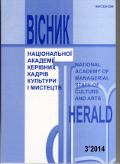SYMPHONY № 2 BY A. JACOBCHUK: PARAMETRES OF NEO-ROMANTICISM
DOI:
https://doi.org/10.32461/2226-3209.3.2014.138119Keywords:
Neo-Romanticism, Ukrainian music, symphony, A. JacobchukAbstract
Highlighting features of manifestation of neo-romanticism in Ukrainian music belongs to the problems of style, which is one of the leading scientific topics in modern musicology. In particular, two issues of "Science Bulletin" National Music Academy of Ukraine [12; 13], which contain the articles about aesthetic, theoretical aspects of the subject, examine the issue of performance styles, specifically are devoted to it.
The objective of this paper is to examine the Second Symphony by A. Jacobchuk to highlight its neo-romantic
stylistic direction that raises as one consequence of the evolution of Ukrainian symphony during postmodern era. This work – a striking example of the symphonic genre Ukrainian music of the 1980s – is indicative of ambiguity in semantic layers, using a two-part version cycle, combined mono-thematic principle based on modal technique.
Symphony made a huge impression in concept, which clearly does not fit into a common shaft of glorifying Soviet reality works with bravura, optimistic final parts. The work is characterized by extreme Confessional statement of
composer; the artist is as frank with each listener, comparing suppressed deep feelings, thinking about the meaning of human life, its boundary poles: the beginning – childhood, in a harmonious worldview, and completion – a minute of leaving to eternity... Actually, intimacy tone of the symphony touches in a deep way, confusing ambiguity of its meaning, the ability to meet himself, to find his own path in the maze of globalization. Therefore, it naturally fits into a stylistic trend of neo-romanticism of the last third of the 20th century, clearly affirmed in Ukrainian music.
To implementation a plan the composer has chosen again as in the First Symphony, two-part version of cycling,
this time combined on the basis of modal technique by mono-thematic principle (intonation origin of all tunes is based on the sequence of six chromatic semitones consistently come down). However, putting the remark attacca in the end of the first part, composer interprets this two-part version of cycling as indivisible large-scale musical canvas, with its moments of action and inhibited zones of calm. It is the surface level of visual analysis of the score. On the other side, the author directs the development to pairs of antinomies matching active flowing (Part I) and meditation (Part II). In the very same parts he clearly separates into two sections each with disproportionate, but compelling division, in each pair semantically emphasizing the second, more episode. Also A. Jacobchuk uses an idea of the three parts, covertly placing it in the design of the whole. In particular, we observe this in the contrast between volitional character of midpoint (as the second section of Part I) and meditative one of frame sections (as the first section of Part I and the second part of the symphony, remarkable thematic reminiscences of the previous one). So, such ambiguity of dramaturgy lies in ambiguity of semantic layers work, an original sample of symphonic genre in Ukrainian music of the 1980s.
A timbre dramaturgy is an important achievement of the work: numerous solos are causing the value of the personal factor, timbre combinations of solo instruments are providing unusual color to themes, personification of timbres is giving guidance on a particular image, preparing of climactic zones marked by a gradual and systematic build-up of texture. Philosophical interpretation of concluding epilogue, emphasizing its semantic features in the concept of a whole work should be considered as a new achievement too.
Thus, the Second Symphony, no doubt, was the creative success of A. Jacobchuk testified his talent as a composer with symphonic mentality and it is no exaggeration to say, while opening new horizons of genre in the late 1980s. Written in the times so-called "perestroika," it countered creative freedom of self-expression by author and its introvert character to that time inter-discourse.
In future I see the coverage of other works of A. Jacobchuk marked tendency to neo-romanticism as a perspective plan that give grounds for a holistic understanding of value of this tendency in the composer`s works and in Ukrainian musical context totally of the last third of the twentieth century.
Downloads
Published
Issue
Section
License
Authors who publish with this journal agree to the following terms:
1. Authors retain copyright and grant the journal right of first publication with the work simultaneously licensed under a Creative Commons Attribution License International CC-BY that allows others to share the work with an acknowledgement of the work's authorship and initial publication in this journal.
2. Authors are able to enter into separate, additional contractual arrangements for the non-exclusive distribution of the journal's published version of the work (e.g., post it to an institutional repository or publish it in a book), with an acknowledgement of its initial publication in this journal.
3. Authors are permitted and encouraged to post their work online (e.g., in institutional repositories or on their website) prior to and during the submission process, as it can lead to productive exchanges, as well as earlier and greater citation of published work (See The Effect of Open Access).


